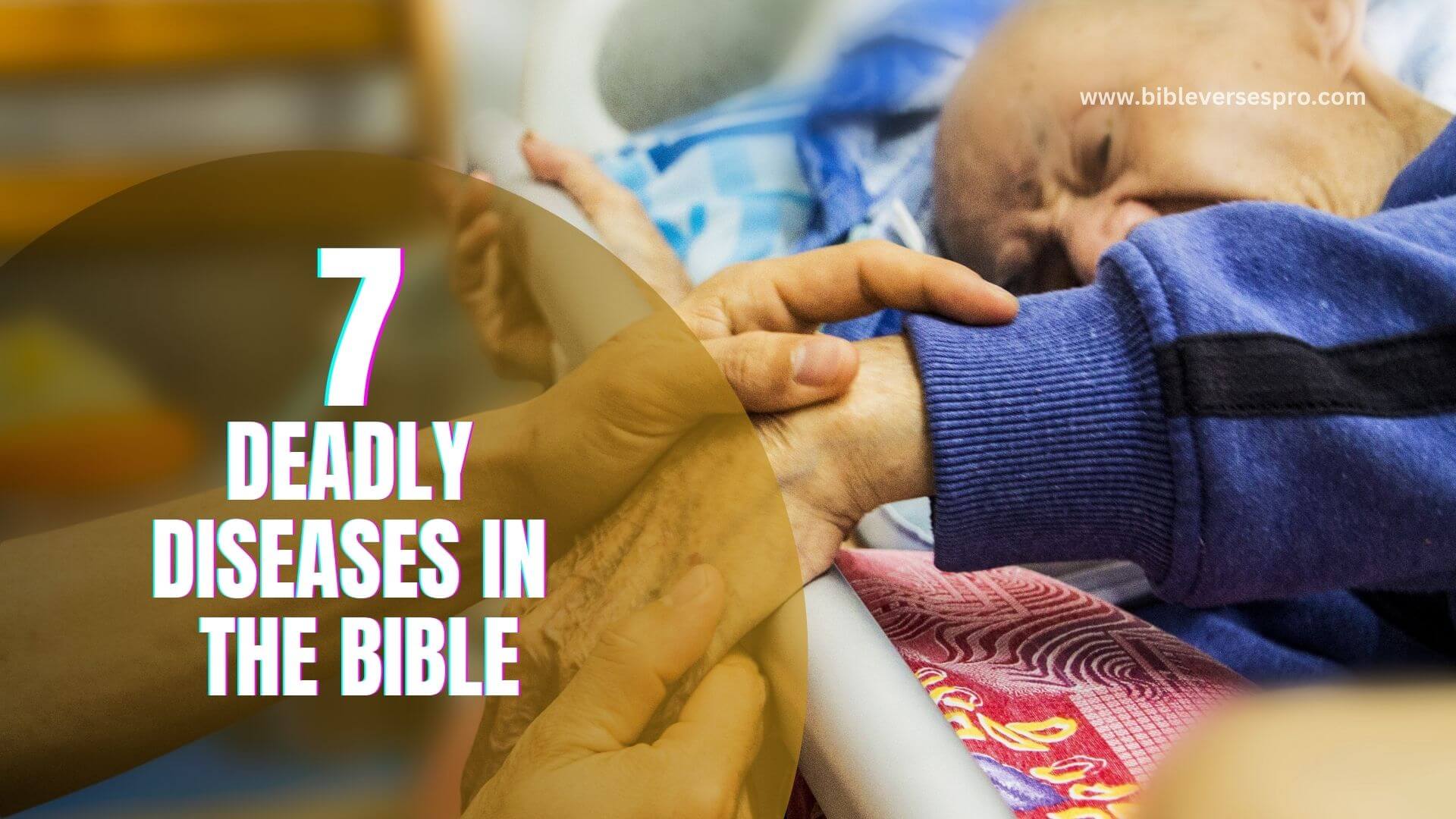Among these struggles are diseases that plagued the people of biblical times, serving as physical manifestations of the brokenness and imperfection inherent in a fallen world.
These diseases, often referred to as the “seven deadly diseases” in the Bible, hold deeper spiritual significance and carry profound lessons for us today.
In exploring the 7 deadly diseases in the Bible, we embark on a journey that unveils the physical, emotional, and spiritual impact of these afflictions on individuals and communities.
From leprosy to blindness, each disease serves as a powerful metaphor, illuminating the spiritual struggles humanity faces and the redemptive power of God’s love and healing.
7 Deadly Diseases In The Bible
In this exploration, we will delve into each of the seven deadly diseases, examining the biblical accounts, their symbolic meanings, and the lessons we can glean from them.
We will witness miraculous healings, encounters with divine judgment, and the restoration of broken bodies and souls.
Through these stories, we will be reminded of God’s sovereignty, His compassion for the afflicted, and the call to seek His healing and redemption in our own lives.
1. Leprosy: A Disease of Isolation and Restoration
Leprosy was a dreaded disease in biblical times, and there are several accounts in the Bible that illustrate the physical, social, and spiritual implications of leprosy.
One such example is Naaman’s healing in 2 Kings 5, where Naaman, a powerful Syrian commander, was afflicted with leprosy but received healing through the prophet Elisha’s instructions.
Stigma and Isolation Of Lepers:
Leprosy carried a significant social stigma and often resulted in the isolation of those affected.
The book of Leviticus provides detailed instructions on how to handle cases of leprosy, emphasizing the need for quarantine and separation from the community to prevent the spread of the disease.
Miraculous Healings and Restoration:
Throughout the Bible, we see instances where God performed miraculous healings, bringing restoration to individuals afflicted with leprosy.
Notable examples include Jesus’ healing of the ten lepers in Luke 17:11-19, where only one returned to thank Him. These healings demonstrate God’s compassion, power, and His desire to restore both physical health and social inclusion.
2. Plague: Divine Judgment and Deliverance
The Old Testament contains accounts of plagues sent by God as judgments on nations or individuals.
The most prominent example is the ten plagues of Egypt, which were inflicted upon Pharaoh and the Egyptians as a result of their refusal to let the Israelites go.
God’s warning and judgment through plagues:
Plagues served as warnings from God, calling people to repentance and to acknowledge His sovereignty.
They demonstrated His power over nature and the false gods of the nations. The plagues also served as judgments on those who resisted God’s authority and oppressed His people.
Deliverance and lessons learned:
Despite the severity of the plagues, God also provided avenues of deliverance for His people.
For example, during the final plague in Egypt, the Israelites were instructed to apply the blood of a lamb to their doorposts, and the Angel of Death passed over their homes. This event marked their deliverance from slavery and became the foundation of the Passover celebration.
The plagues teach us important lessons about God’s faithfulness, the consequences of disobedience, and the need for repentance and trust in His deliverance.
3. Fever: Sickness and Healing in the Bible
Fever is mentioned in various biblical accounts, indicating its presence as a common ailment.
For example, in Matthew 8:14-15, Jesus heals Peter’s mother-in-law, who was suffering from a high fever. Another instance is found in Acts 28:8-9, where the apostle Paul miraculously heals Publius’ father, who had a fever and dysentery.
The impact of fever on individuals and communities:
Fever can be debilitating and have significant effects on both individuals and communities. It causes physical discomfort, weakness, and often disrupts daily life.
In biblical times, fever could lead to isolation, as individuals with fevers were considered contagious and potentially dangerous to others.
Healing and Restoration from Fever:
The Bible records instances where Jesus healed people suffering from fever. His touch or word brought immediate relief and restoration to health.
These accounts demonstrate the healing power of Jesus and His compassion towards those who were sick.
They also encourage us to seek God’s healing provision and place our trust in Him, knowing that He has the power to restore us from sickness and infirmity.
4. Boils: Affliction and the Power of God
Boils are mentioned as a form of affliction in the Bible, often associated with divine judgment.
For instance, during the plagues in Egypt, the sixth plague was boils that afflicted both humans and animals (Exodus 9:8-12). Job, in his suffering, also experienced painful boils (Job 2:7).
Biblical examples of boils and their significance:
Boils serve as a visible and painful affliction, highlighting the severity of God’s judgment or testing. In the case of Job, his boils were part of his testing and the spiritual battle taking place behind the scenes.
God’s power and deliverance from boils:
Although boils were a severe affliction, we see examples of God’s power and deliverance.
In the book of Job, after enduring tremendous suffering, Job experiences restoration and healing from his afflictions.
These examples remind us that even in the face of affliction and pain, God is able to bring healing and restoration, demonstrating His power and faithfulness to His people.
5. Blindness: Physical and Spiritual Darkness
The Bible contains numerous accounts of individuals who experienced blindness, such as Bartimaeus in Mark 10:46-52 and the man born blind in John 9. These stories highlight the physical condition of blindness and its impact on individuals and their interactions with Jesus.
Symbolism of blindness in relation to spiritual sight:
Blindness is often used metaphorically to represent spiritual darkness and the inability to perceive God’s truth.
It symbolizes the need for spiritual enlightenment and the transformative power of encountering Jesus, who is the light of the world.
Healing and restoration of sight in the Bible:
Jesus performed miraculous healings of blindness, demonstrating His power to restore physical sight.
These healings also carry a deeper symbolic meaning, representing the spiritual illumination and revelation that comes through faith in Christ.
6. Demon Possession: Spiritual Oppression and Deliverance
The New Testament accounts several instances of individuals who were tormented by evil spirits and demon possession. Examples include the Gerasene demoniac in Mark 5:1-20 and the girl possessed by a spirit of divination in Acts 16:16-18.
Effects of demonic influence on individuals:
Demon possession leads to significant spiritual, emotional, and sometimes physical oppression.
It can result in destructive behaviors, loss of control, and separation from God and society.
Jesus’ authority and deliverance from demonic oppression:
Jesus displayed His authority over demons by casting them out and setting people free. His ministry revealed the power of God to overcome spiritual darkness, providing deliverance and freedom from demonic oppression.
7. Deafness and Muteness: Spiritual Deafness and Divine Restoration
The Bible mentions individuals who were deaf and mute, such as the man in Mark 7:31-37 and the boy possessed by a mute spirit in Mark 9:17-27.
These stories illustrate the physical limitations and challenges faced by those who experience these conditions.
Spiritual implications of being spiritually deaf or mute:
Deafness and muteness can symbolize spiritual conditions, representing the inability to hear and speak God’s truth.
It highlights the need for spiritual awakening, receptive hearts, and vocal proclamation of God’s message.
Divine healing and restoration of hearing and speech:
In the Bible, we see instances where Jesus healed the deaf and mute, restoring their ability to hear and speak.
These miracles signify not only physical healing but also the transformative power of God’s grace to open hearts and enable people to share His message.
Other Diseases In The Bible
These are just a few examples of diseases and conditions mentioned in the Bible. Each of these instances provides an opportunity to explore God’s healing power, His compassion towards the afflicted, and the significance of faith in seeking divine intervention.
- Palsy: Palsy refers to a condition characterized by paralysis or loss of muscle control. In the Bible, instances of palsy include the healing of the paralyzed man in Mark 2:1-12 and the healing of the man with a withered hand in Luke 6:6-11.
- Dropsy: Dropsy, also known as edema, is a condition characterized by the accumulation of fluid in body tissues. It is mentioned in Luke 14:1-6, where Jesus heals a man with dropsy on the Sabbath.
- Dysentery: Dysentery is an infection of the intestines that causes diarrhea, abdominal pain, and sometimes blood in the stool. It is briefly mentioned in Acts 28:8-9 when Paul heals Publius’ father, who was suffering from dysentery along with fever.
- Paralysis: Paralysis refers to the loss of muscle function or sensation in a part of the body. The Bible mentions instances of paralysis, such as the healing of the paralyzed man at the Pool of Bethesda in John 5:1-15 and the healing of Aeneas, who had been bedridden for eight years, in Acts 9:32-35.
- Lame/Lameness: Lameness refers to a physical disability that impairs a person’s ability to walk normally. In the Bible, we see examples of the lame being healed, such as the healing of the lame beggar at the Beautiful Gate in Acts 3:1-10.
- Hemorrhage: Hemorrhage refers to excessive bleeding, often associated with a specific body part or organ. The Bible mentions a woman with an issue of blood who experienced continuous bleeding for twelve years. She was healed when she touched the hem of Jesus’ garment (Mark 5:25-34).
- Demoniac: While not a physical disease, demon possession is described in the Bible as a spiritual affliction that causes individuals to be under the control and influence of evil spirits. Examples include the Gerasene demoniac in Mark 5:1-20 and the man with a mute spirit in Mark 9:17-27.
Conclusion
As we contemplate the seven deadly diseases in the Bible, let us carry the lessons learned into our own lives.
May we be reminded of the importance of compassion, empathy, and inclusivity towards those suffering from physical ailments.
Let us cultivate a spirit of repentance, seeking God’s forgiveness and restoration. And may we embrace the transformative power of encountering Jesus, the One who can heal our deepest wounds and bring wholeness to our brokenness.
In the face of disease, may we find solace in the promise of God’s presence, comfort in His love, and strength in our faith. For it is in Him that we find true healing, both in this life and for all eternity.








1 comment
Thank you for this wonderful teaching.i appreciate your gesture.God bless you all ijn Amen